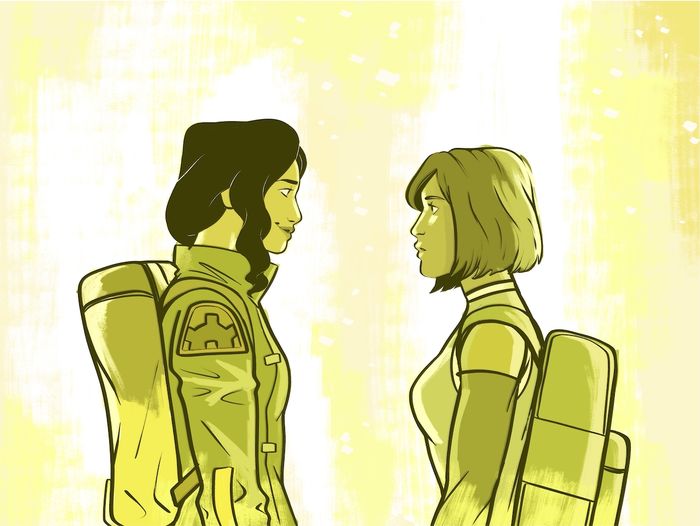Animation and the cinema of trauma
Film&TV columnist Miruna Tiberiu discusses the exceptional potential of animation to represent trauma in ways that live-action cinema will never be able to
Content Note: This article discusses war related hardship, trauma, and violence.
We are often most surprised when an animated film makes us cry. It somehow makes more sense for that heart-wrenching close up at the end of Titanic (1998) to make you weep, then watching a striped scarf, belonging to the now-dead protagonist of Chris the Swiss (2018), float away in a gust of pencilled-in wind.
When attempting to depict tales of political sacrifice and hardship, filmmakers often turn to the cinematic world that is closest to our own, that of live action. But what so many hard-hitting animated dramas have proven time and time again is that the most realistic portrait of human beings is not always the most accurate. How can you break through this mirror of reality and reach for the psychological trauma, so absurd and so indescribable in its very nature, to seek the true experiences that individuals have had to struggle through? The answer, for many cinematic artists, is animation.
Most of us, fortunately, have never had to live out our years in a prisoner-of-war camp, or face the disillusionment of ‘fighting for our country’ when that country is divided and slowly killing itself, alongside the many other horrors of war. In light of such unspeakable tragedy, animation is often the translation device that we need to bring these emotions to the screen. How better to allow an audience to peek through into the messy depths of personal trauma than by literally drawing it for them? Within animated films, our eyes take in each frame with a level of attention not seen in live action films. We are forced to decipher the sketches; they do not offer the realism we take for granted in our everyday lives. Recreating a lived experience through live action, and attempting to mirror it exactly, can never hope to become the experience itself. Animation, however, is a common ground for both filmmaker and audience through which to portray these experiences that cannot be acted out.
“Like the process of sketching a scene right in front of the eager eyes of the audience, so these filmmakers experience the process of dealing with their trauma as they animate the world of their films”
Not even the protagonists themselves can fully decipher their own minds. Trauma and grief, like the death that so often spurs them on, are beyond our frame of comprehension as human beings. Aurel’s 2020 film Josep, which chronicles the experiences of a French gendarme guarding a Spanish political prisoner camp under Franco’s regime, is full of these reality-bending experiences. We can only feel the narrator’s boiling hatred for his co-workers, men who embrace their inhuman tasks, who smile as they torture, humiliate and murder prisoners, through the sketches that emerge out of his mind. In the film, they are reduced to pigs, ears and snouts gradually being drawn over their figures. As they accept their inhuman task, these gendarmes cease to be human. Or perhaps they get a taste of their own medicine. They are humiliated in the eyes of the audience, dehumanised. This absurd episode can only be given birth to through animation.
In each and every one of these films, the pencil is the most powerful tool. Through all the humiliation he faces, the constant state of bruising that his entire body has to get used to, the years spent away from his lover, Josep grips the stub of a pencil with all his might. Every surface that he draws on becomes his own, and when paper is a luxury unavailable to him he turns to the very ground, sketching his mind out onto the blood-stained dust of the concentration camp. In Anja Kofmel’s Chris the Swiss, too, the narrator, a child at the time, is only allowed to grieve through her art. The black mess of childish squiggles, increasing in violence as she picks up the pace of her drawing, reflect this looming yet faceless danger of death. As a child, she does not yet know what death is, and still the word hangs over her for years, dunking her into a deep grief as she must face her cousin Chris’ politically-fuelled assassination following his time as a war photographer during the Yugoslav wars.
Grief, unlike the still image of a live action film, manifests itself in a constant fluctuating state. Like the process of sketching a scene right in front of the eager eyes of the audience, so these filmmakers experience the process of dealing with their trauma as they animate the world of their films. It is a process that never stops, as their minds act like this powerful tool of the pencil, erasing parts of the painful memories and shading in others on top.
 Features / Should I stay or should I go? Cambridge students and alumni reflect on how their memories stay with them15 December 2025
Features / Should I stay or should I go? Cambridge students and alumni reflect on how their memories stay with them15 December 2025 News / Cambridge study finds students learn better with notes than AI13 December 2025
News / Cambridge study finds students learn better with notes than AI13 December 2025 News / Dons warn PM about Vet School closure16 December 2025
News / Dons warn PM about Vet School closure16 December 2025 News / News In Brief: Michaelmas marriages, monogamous mammals, and messaging manipulation15 December 2025
News / News In Brief: Michaelmas marriages, monogamous mammals, and messaging manipulation15 December 2025 Comment / The magic of an eight-week term15 December 2025
Comment / The magic of an eight-week term15 December 2025









